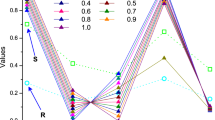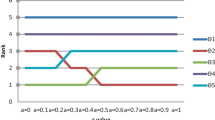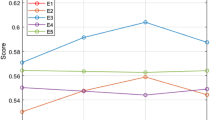Abstract
The picture fuzzy set (PFS) proposed by Cuong and Kreinovich are well suitable to capture the uncertain information in vague circumstances. The main objective of this communication is to propose a new framework as a criteria of fuzzy entropy for PFSs. Further, a new picture fuzzy information measure based on Tsallis–Havrda–Charvat entropy is proposed and validated in accordance with newly proposed framework. Besides this, some major properties of proposed information measure are also discussed. Apart from this, a new multi-criteria decision-making method using the concept of VIKOR (Vlsekriterijumska Optimizacija i Kompromisno Resenje) based on relative projection is proposed. To show the practical utility of proposed decision-making method, two numerical examples based on election forecast through opinion polls have been discussed.
Similar content being viewed by others
References
Aqlan F, Lam SS (2015) A fuzzy-based integrated framework for supply chain risk assessment. Int J Prod Econ 161:54–63
Atanassov KT (1986) Intutionistic fuzzy sets. Fuzzy Sets Syst 20:87–96
Atanassov KT (1999) Intutionistic fuzzy sets. Springer, New York
Bajaj RK, Kumar T, Gupta N (2012) \(R\)-norm intutionistic fuzzy information measures and its computational applications, ICECCS 2012. CCIS 305:372–380
Benayoun R, Roy B, Sussman B (1966) ELECTRE: Une méthode pour guider le choix en présence de points de vue multiples, Note de travail 49. SEMA-METRA International, Direction Scientifique, Paris
Bhandari D, Pal NR (1993) Some new information measures for fuzzy sets. Inf Sci 67(3):204–228
Boekee DE, Vander Lubbe JCA (1980) The \(R\)-norm information measure. Inf Control 45:136–155
Brans JP, Mareschel V (1984) PROMETHEE: a new family of outranking methods in multicriteria analysis. In: Brans JP (ed) Operational research’ 84. North-Holland, New York, pp 477–490
Burillo P, Bustince H (2001) Entropy on intutionistic fuzzy sets and on interval-valued fuzzy sets. Fuzzy Sets Syst 118:305–316
Chen T, Li C (2010a) Determinig objective weights with intutionistic fuzzy entropy measures: a comparative analysis. Inf Sci 180:4207–4222
Chen T, Li C (2010b) Determining objective weights with intuitionistic fuzzy entropy measures: a comparative analysis. Inf Sci 180:4207–4222
Choo EU, Wedley WC (1985) Optimal criterian weights in repetitive multicriteria decision making. J Oper Res Soc 36:983–992
Chou SY, Chang YH, Shen CY (2008) A fuzzy simple additive weighting system under group decision-making for facility location selection with objective/subjective attributes. Eur J Oper Res 189:132–145
Chu ATW, Kalaba RE, Spingarn K (1979) A comparison of two methods for determining the weights of belonging to fuzzy sets. J Optimiz Theor App 27:531–538
Cuong BC, Kreinovich V (2012) Picture fuzzy sets-a new concept for computational intelligence problems. In: Proceedings of of 3rd world congress on information and communication technologies (WICT), pp 1–6
De Luca A, Termini S (1972) A definition of non-probabilistic entropy in the setting of fuzzy set theory. Inf Control 20(1972):301–312
Deng Y (2012) D Numbers: theory and applications. J Inf Comput Sci 9(9):2421–2428
Dubois D, Prade H (1990) Rough fuzzy sets and fuzzy rough sets. Int J Gener Syst 17:191–209
Fan ZP (1996) Complicated multiple attribute decision making: theory and applications. Ph.D. Dissertation, Northeastern university, Shenyang, China
Grattan-Guiness I (1975) Fuzzy membership mapped onto interval and many-valued quantities. Z Math Logik Grundladen Math 22:149–160
Havdra JH, Charvat F (1967) Quantification method classification process: concept of structral \(\alpha \)-entropy. Kybernetika 3:30–35
Hooda DS (2004) On generalized measures of fuzzy entropy. Math Slovaca 54:315–325
Hung WL, Yang MS (2006) Fuzzy entropy on intutionistic fuzzy sets. Int J Intell Syst 21:443–451
Hung WL, Yang MS (2008) On the J-divergence of intuitionistic fuzzy sets with its application to pattern recognition. Inf Sci 178:1641–1650
Hwang CL, Lin MJ (1987) Group decision making under multiple criteria: methods and applications. Springer, Berlin
Hwang CL, Yoon KP (1981) Multiple attribute decision-making: methods and applications. Springer, New York
Jahn KU (1975) Intervall-wertige Mengen. Math Nach 68:115–132
Jiang YC, Tang Y, Wang J, Tang S (2009) Reasoning within intuitionistic fuzzy rough description logics. Inf Sci 179:2362–2378
Joshi R (2019) A new multi-criteria decision-making method based on intuitionistic fuzzy information and its application to fault detection in a machine. J Ambient Intell Human Comput. https://doi.org/10.1007/s12652-019-01322-1
Joshi R, Kumar S (2016) \((R, S)\)-norm information measure and a relation between coding and questionnaire theory. Open Syst Inf Dyn 23(3):1–12
Joshi R, Kumar S (2018a) An intuitionistic fuzzy \((\delta,\gamma )\)-norm entropy with its application in supplier selection problem. Comput Appl Math. https://doi.org/10.1007/s40314-018-0656-9
Joshi R, Kumar S (2018b) An intuitionistic fuzzy information measure of order \((\alpha, \beta )\) with a new approach in supplier selection problems using an extended VIKOR method. J Appl Math Comput. https://doi.org/10.1007/s12190-018-1202-z
Joshi R, Kumar S (2018c) A new parametric intuitionistic fuzzy entropy and its applications in multiple attribute decision making. Int J Appl Comput Math 4:52–74
Joshi R, Kumar S (2018d) A new weighted \((\alpha, \beta )\)-norm information measure with applications in coding theory. Phys A Stat Mech Appl 510:538–551
Joshi R, Kumar S (2018e) A novel fuzzy decision making method using entropy weights based correlation coefficients under intuitionistic fuzzy environment. Int J Fuzzy Syst. https://doi.org/10.1007/s40815-018-0538-8
Joshi R, Kumar S (2018f) An \((R^{\prime }, S^{\prime })\)-norm fuzzy relative information measure and its application in strategic decision-making. Appl Math Comp. https://doi.org/10.1007/s40314-018-0582-x
Kapur JN (1997) Measures of fuzzy information. Mathematical Sciences Trust Society, New Delhi
Nei R-X, Wang J-Q, Wang T-L (2018) A hybrid outranking method for greenhouse gas emissions’ institution selection with picture 2-tuple linguistic information. Comput Appl Math 37(5):6676–6699
Nie R-X, Wang J-Q, Li L (2017) A shareholder voting method for proxy advisory firm selection based on 2-tuple linguistic picture preference relation. Appl Soft Comput 60:520–539
Opricovic S (1998) Multi-criteria optimization of civil engineering systems. Ph.D. Thesis, University of Belgrade, Belgrade, Serbia
Opricovic S, Tzeng G-H (2004) Decision aiding compromise solution by MCDM methods: a comparative analysis of VIKOR and TOPSIS. Eur J Oper Res 156:445–455
Opricovic S, Tzeng GH (2007) Extended VIKOR method in comparison with outranking methods. Eur J Oper Res 178:514–529
Pillay A, Wang J (2015) A risk ranking approach incorporating fuzzy set theory and grey theory. Reliabil Eng Syst Saf 1(10):23–25
Renyi A (1961) On measures of entropy and information. In: Proceedings of 4th Barkley symposium on mathematical statistics and probability. University of California Press, vol 1, pp 547–561
Saaty TL (1980) The analytical hierarchy process. McGraw-Hill, New York
Shannon CE (1948) A mathematical theory of communication. Bell Syst Tech J 27:379–423
Shen K-W, Wang J-Q (2018) Z-VIKOR method Based on a new comprehensive weighted distance measure of Z-number and its application. IEEE Trans Fuzzy Syst 26(6):3232–3245
Son LH (2016) Generalized picture distance measure and its application to picture fuzzy clustering. Appl Soft Comput 46:284–295
Son LH (2017) Measuring analogousness in picture fuzzy sets: from picture distance measures to picture association measures. Fuzzy Optim Decis Mak 16:1–20
Szmidt E, Kacprzyk J (2000) Distances between intuitionistic fuzzy sets. Fuzzy Set Syst 114:505–518
Torra V, Narukawa Y (2009) On hesitant fuzzy sets and decision. 18th IEEE conference on fuzzy systems. Jeju Island, Korea, pp 1378–1382
Tsallis C (1988) Possible generalization of Boltzman-Gibbs statistics. J Stat Phys 52:480–487
Vlachos IK, Sergiadis GD (2007) Intuitionistic fuzzy information–applications to pattern recognition. Pattern Recognit Lett 28(2):197–206
Wang J, Wang P (2012) Intutionistic linguistic fuzzy multi-critria deision-making method based on intutionistic fuzzy entropy. Control Decis 27:1694–1698
Wang L, Zhang HY, Wang JQ, Li L (2018) Picture fuzzy normalized projection-based VIKOR method for the risk evaluation of construction project. Appl Soft Comput 64:216–226
Wang L, Zhang H-Y, Wang J-Q, Wu G-F (2018) Picture fuzzy multi-criteria group decision-making method to hotel building energy efficiency retrofit project selection. RAIRO Oper Res. https://doi.org/10.1051/ro/2019004
Wang X, Wang J, Zhang H (2018) Distance-based multicriteria group decision making approach with probabilistic linguistic term sets. Expert Syst. https://doi.org/10.1111/exsy.12352
Wang L, Peng J-J, Wang J-Q (2018) A multi-criteria decision-making framework for risk ranking of energy performance contracting project under picture fuzzy environment. J Clean Prod 191:105–118
Wang R, Wang J, Gao H, Wei G (2019) Methods for MADM with picture fuzzy muirhead mean operators and their application for evaluating the financial investment risk. Symmetry 11(1):6
Wei GW (2016) Picture fuzzy cross-entropy for multiple attribute decision making problems. J Bus Econ Manag 17(4):491–502
Wei GW (2018) Some more similarity measures for picture fuzzy sets and their applications. Iran J Fuzzy Syst 15(1):77–89
Wei G (2018) TODIM method for picture fuzzy multiple attribute decision making. Informatica 29(3):555–566
Wei G, Gao H (2018) The generalized dice similarity measures for picture fuzzy sets and their applications. Informatica 29(1):107–124
Wei G, Alsaadi FE, Hayat T, Alsaedi A (2016) Projection models for multiple attribute decision making with picture fuzzy information. Int J Mach Learn Cybern. https://doi.org/10.1007/s13042-016-0604-1
Wei G, Alsaadi FE, Hayat T, Alsaedi A (2018) Picture 2-tuple linguistic aggregation operators in multiple attribute decision making. Soft Comput 22(3):989–1002
Xu ZS, Yager RR (2006) Some geometric aggregation operators based on intuitionistic fuzzy sets. Int J Gen Syst 35:417–433
Xu ZS, Yager RR (2008) Dynamic intuitionistic fuzzy multi-attribute decision making. Int J Approx Reason 48:246–262
Yager RR (1979) On the measure of fuzziness and negation part I: membership in the unit interval. Int J Gen Syst 5(4):221–229
Yager RR (1988) On ordered weighted averaging aggregation operators in multicriteria decision making. IEEE Trans Syst Man Cybern 18:183–190
Yager RR (2004) Generalized OWA aggregation operators. Fuzzy Optim Decis Mak 3:93–107
Yu PL (1973) A class of solutions for group decision making problem. Manag Sci 19:936–946
Zadeh LA (1965) Fuzzy sets. Inf Comput 8(3):338–353
Zadeh LA (1968) Probability measures of fuzzy events. J Math Anal Appl 23:421–427
Zadeh LA (1975) The concept of a linguistic variable and its application to approximate reasoning-I. Inform Sci 8:199–249
Zeng W, Yu F, Yu X, Chen H, Wu S (2009) Entropy on intuitionistic fuzzy set based on similarity measure. Int J Innov Comput Inf Control 5(12):4737–4744
Zhang XY, Wang J-Q, Hu JH (2017) On novel operational laws and aggregation operators of picture 2-tuple linguistic information for MCDM problems. Int J Fuzzy Syst 20(6):1–12
Zhang X-Y, Wang X-K, Yu S-M, Wang J-Q, Wang T-L (2018) Location selection of offshore wind power station by consensus decision framework using picture fuzzy modelling. J Clean Prod 202:980–992
Zhang S, Gao H, Wei G, Wei Y, Wei C (2019) Evaluation based on distance from average solution method for multiple criteria group decision making under picture 2-tuple linguistic environment. Mathematics 7(3):243
Zhao N, Xu ZS (2016) Entropy measures for interval valued intuitionistic fuzzy information from a comparative perspective and their application to decision making. Informatica 27:203–228
Zhu B, Xu Z (2018) Probability-Hesitant fuzzy sets and the representation of preference relations. Technol Econ Dev Econ 24(3):1029–1040
Author information
Authors and Affiliations
Corresponding author
Additional information
Communicated by Marcos Eduardo Valle.
Publisher's Note
Springer Nature remains neutral with regard to jurisdictional claims in published maps and institutional affiliations.
Appendix
Appendix
Proof of Theorem (4.3):
To prove theorem (4.3), we divide X into two parts say \(X_1\) and \(X_2\) such that
Then for all \(\kappa _i\in X_1\),
and for all \(\kappa _i\in X_2\),
Using (4.8),
Similarly,
Corollary: For any PFS \(\vartheta \) and its complement \(\vartheta ^c\), we have
Rights and permissions
About this article
Cite this article
Joshi, R. A new picture fuzzy information measure based on Tsallis–Havrda–Charvat concept with applications in presaging poll outcome. Comp. Appl. Math. 39, 71 (2020). https://doi.org/10.1007/s40314-020-1106-z
Received:
Revised:
Accepted:
Published:
DOI: https://doi.org/10.1007/s40314-020-1106-z




